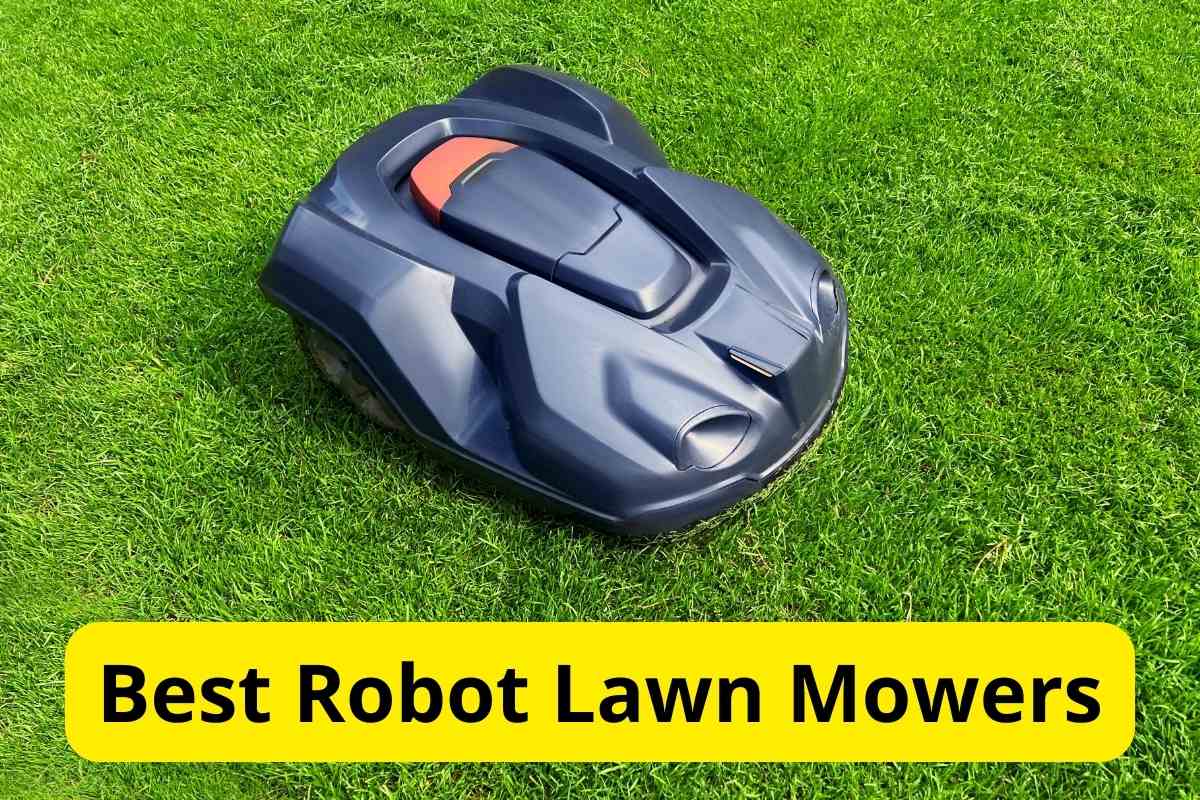
With modern technology, lawn mowing can be a “set it and forget it” affair. What’s the best robot lawn mower for you and your yard? We did the research for you!
We compare models from America’s leading lawn care retailers— Home Depot, Lowe’s, Amazon, and Walmart. Based on performance, functionality, and value, we found our top robotic lawn mower picks. Our detailed reviews and info-rich buyer’s guide make it easy to find the best robotic mower to suit your individual needs.
Our Top Picks
| 1. Mammotion Luba AWD 5000 |
| 2. EcoFlow ZMH100-B-US-V20 |
| 3. Robomow RK4000 |
| 4. Husqvarna Automower 430X |
| 5. Worx Landroid L WR115 |
| 6. Yard Force NX100i |
| 7. Gardena Sileno City 15002-20 |
Top 7 Robotic Mowers – Reviews
1. Mammotion Luba AWD 5000
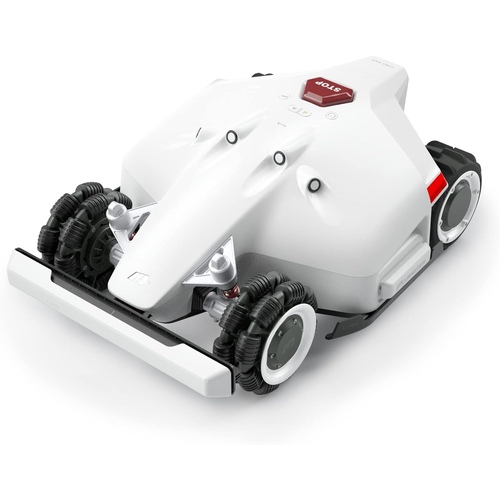
Mammotion Luba AWD 5000
Perimeter wire-free, all-wheel drive for 75% slopes, in-app multi-zone management, mows 1.25 acres, and includes safety features.
Being the only mower on our list with all-wheel drive, the Mammotion Luba AWD 5000 is the best robotic mower for large, hilly yards. Although it’s our list’s second most expensive mower, it’s well worth it as it handles the largest yards and the steepest slopes. It’s also highly efficient, using math instead of random mowing patterns to plan routes.
The Luba AWD 5000 is filled with fancy features, including obstacle avoidance, auto-recharge, and in-app multi-zone management. The setup is super simple, with no guide wires and a multi-sensor navigation system. It also comes with safety features such as a tilt blade-stop sensor and theft protection.
Specifications
- Battery: 10 Ah
- Connectivity: Bluetooth, Wi-Fi
- Cutting heights: 1.18 – 2.8 in.
- Cutting width: 15.7 in.
- Lawn size: Up to 1.2 acres
- Max slope: 38°
- Noise level: 60 dB
Special Features
| All-Wheel Drive | Yes |
| Anti-theft | Yes |
| GPS | Yes |
| Virtual Assistant Compatible | No |
Pros and Cons
| What We Liked | What We Didn’t Like |
| ✓ No boundary wires ✓ Wi-Fi connectivity ✓ Great for steep slopes ✓ Great for rugged terrain ✓ Feature-packed ✓ Quiet | ✗ Narrow range of cutting heights ✗ Expensive |
2. EcoFlow ZMH100-B-US-V20
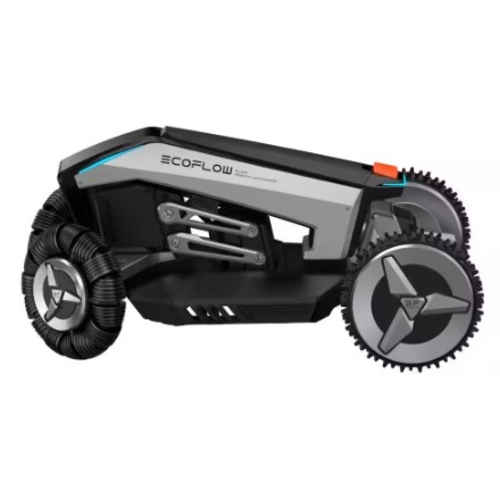
EcoFlow ZMH100-B-US-V20
Industry’s first lawn sweeping mower, wire-free boundaries, smart obstacle avoidance, automatic route planning, anti-theft, and comprehensive 4-year warranty.
The EcoFlow ZMH100-B-US-V20 is the best robotic lawn mower for homeowners with medium to large yards, lots of rain, and wiggle room in their budgets. It’s the most expensive mower on our list, but it’s very durable and can handle yards up to 1 acre. It has built-in rain sensors, IPX5 water resistance, and a 4-year consumer warranty.
It’s easy to set up with wireless boundaries and automatic route planning. You can use the user-friendly app to teach the EcoFlow blade where to mow, and the mower also has superior obstacle avoidance. EcoFlow uses cutting-edge sensor technology to ensure you get a high-quality, complete cut every time.
Specifications
- Battery: 20 volts
- Connectivity: Bluetooth
- Cutting heights: 0.8 – 3 in.
- Cutting width: 10 in.
- Lawn size: Up to 1 acre
- Max slope: 27°
- Noise level: 62 dB
Special Features
| All-Wheel Drive | No |
| Anti-theft | Yes |
| GPS | Yes |
| Virtual Assistant Compatible | No |
Pros and Cons
| What We Liked | What We Didn’t Like |
| ✓ No boundary wires ✓ Highly durable ✓ Great for rainy climates ✓ Feature-packed ✓ Mows low ✓ Quiet | ✗ Expensive |
3. Robomow RK4000
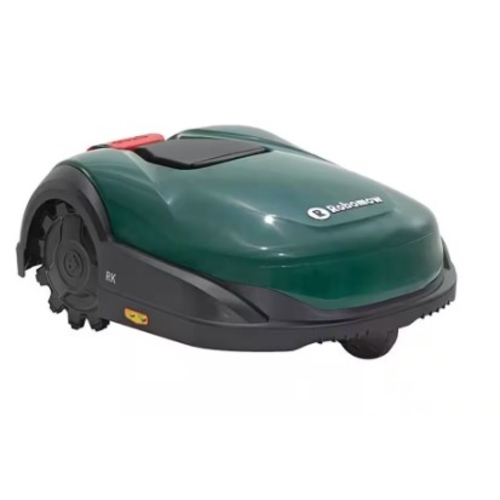
Robomow RK4000
Handles slopes up to 45%, easy setup and maintenance, precise edging, strong cutting system, multiple zones, and safety features.
The Robomow RK4000 is the best robotic mower for tall grass, but it also handles short grass with ease. Robomow makes robotic mowers with the broadest range of height adjustments (0.8 to 4 inches), and the RK4000 has the highest max height out of all the robotic mowers suitable for large yards. It will give high-quality cuts thanks to its staggered blades, which cut smoothly and evenly.
The RK4000 is durable and easy to use, and although it’s a little pricey, this mower has fantastic specs. Its floating deck helps it handle uneven terrain, and the child lock keeps your kids safe. This mower trims pristine edges around landscaping, and you can program multiple cutting zones. It even has remote access via a mobile device.
Specifications
- Battery: 18 volts, 9.6 Ah
- Connectivity: Bluetooth, Cellular
- Cutting heights: 0.8 – 4 in.
- Cutting width: 16 in.
- Lawn size: Up to 1 acre
- Max slope: 24°
- Noise level: 53 – 65 dB
Special Features
| All-Wheel Drive | No |
| Anti-theft | Yes |
| GPS | Yes |
| Virtual Assistant Compatible | No |
Pros and Cons
| What We Liked | What We Didn’t Like |
| ✓ Mows low and high ✓ Durable ✓ Great for uneven terrain ✓ Great safety features ✓ Quiet | ✗ Uses a boundary wire |
4. Husqvarna Automower 430X
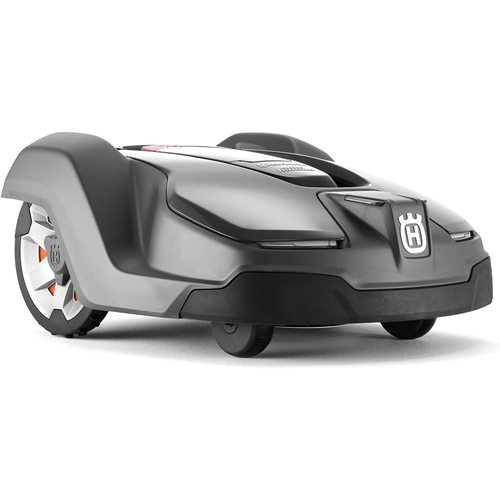
Husqvarna Automower 430X
Smart home integration, energy-efficient battery power, patented features, weather resilience, and built-in theft protection with GPS tracking and PIN code activation.
The best robotic mower to use with a virtual assistant is the Husqvarna Automower 430X. It works well with both Alexa and Google Assistant. Mowing is super simple to manage with the Automower Connect App; you can even remotely adjust its cutting height via the app.
The 430X is a high-quality mower with three carbon steel blades that make crisp, clean cuts. It’s also loaded with premium features, including collision sensors, weather-resilient construction, theft tracking, and an alarm. The placement of its charging station is flexible, and the mower automatically goes to the charger when it needs more juice.
Specifications
- Battery: 18 volts, 5 Ah
- Connectivity: Bluetooth, Cellular
- Cutting heights: 0.8 – 2.4 in.
- Cutting width: 8.45 in.
- Lawn size: Up to ⅘ acre
- Max slope: 24°
- Noise level: 58 dB
Special Features
| All-Wheel Drive | No |
| Anti-theft | Yes |
| GPS | Yes |
| Virtual Assistant Compatible | Yes |
Pros and Cons
| What We Liked | What We Didn’t Like |
| ✓ Mows low ✓ Quiet ✓ Feature-packed ✓ High-quality blades ✓ Great anti-theft protection ✓ Works well with virtual assistants | ✗ Not good for tall grass ✗ Uses a boundary wire ✗ Narrow cutting height range ✗ Expensive |
5. Worx Landroid L WR115
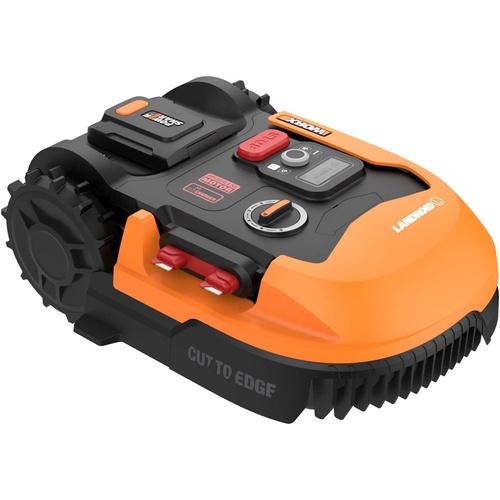
Worx Landroid L WR115
Fully automated robotic lawnmower for up to ½ acre, app-controlled, patented AIA cutting algorithm, and uses a 20V 6.0Ah Power Share battery.
The best robotic mower for medium yards is the Worx Landroid L WR115. It costs less than the average robotic mower but is capable of cutting lawns up to 21,780 square feet. It’s also excellent at navigating around obstacles and mowing through narrow paths. Additionally, it has a floating blade that lifts, so the mower doesn’t get stuck in uneven terrain.
The WR115 has a high-efficiency brushless motor and runs on Worx’s PowerShare batteries. So, the mower’s battery can also power other Worx outdoor tools. The mower is easy to manage through its mobile app, and an Alexa skill is available for virtual assistance.
Specifications
- Battery: 20 volts, 6 Ah
- Connectivity: Bluetooth, Wi-Fi
- Cutting heights: 1.5 – 4 in.
- Cutting width: 8 in.
- Lawn size: Up to ½ acre
- Max slope: 20°
- Noise level: 63 dB
Special Features
| All-Wheel Drive | No |
| Anti-theft | Sold separately |
| GPS | No |
| Virtual Assistant Compatible | Alexa app available |
Pros and Cons
| What We Liked | What We Didn’t Like |
| ✓ Great obstacle avoidance ✓ Mows high ✓ Affordable ✓ Wi-Fi connectivity ✓ Alexa skill available ✓ Good for narrow passages | ✗ Not good for very short grass ✗ Can’t handle steep slopes ✗ Uses a boundary wire |
6. Yard Force NX100i
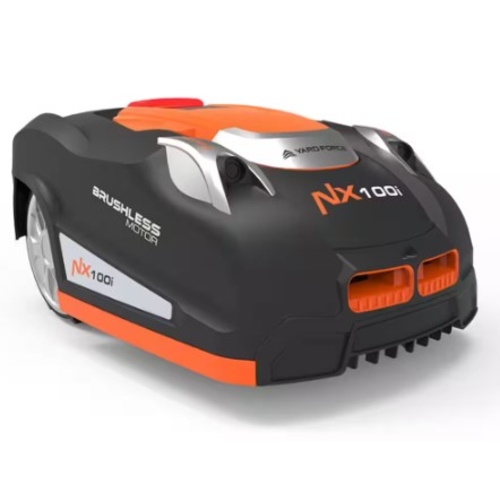
Yard Force NX100i
State-of-the-art robot mower, controlled via phone, Wi-Fi compatibility, rain sensors, silent operation, suitable for 1/3 acre, and complete kit with 2-year warranty.
The robotic mower that gives you the best bang for your buck is the Yard Force NX100i. It costs about as much as the Gardena Sileno City 15002-20 but can handle much larger yards (up to ⅓ acre).
It may not have all the bells and whistles of high-end models, but I wouldn’t call it stripped down either. It comes with many coveted features, including safety ultrasonic sensors, rain sensors, and Wi-Fi connectivity. Additionally, the mower has three razor-sharp blades that cleanly cut grass blades and finely mulch the clippings.
Specifications
- Battery: 28 volts, 2.8 Ah
- Connectivity: Bluetooth, Wi-Fi
- Cutting heights: 1.3 – 3 in.
- Cutting width: 7 in.
- Lawn size: Up to ⅓ acre
- Max slope: 22°
- Noise level: 57 dB
Special Features
| All-Wheel Drive | No |
| Anti-theft | No |
| GPS | No |
| Virtual Assistant Compatible | No |
Pros and Cons
| What We Liked | What We Didn’t Like |
| ✓ Affordable ✓ Wi-Fi connectivity ✓ Ultrasonic sensors ✓ Quiet ✓ Sharp blades | ✗ Narrow cutting height range ✗ Not as many features as high-end models ✗ Uses a boundary wire |
7. Gardena Sileno City 15002-20
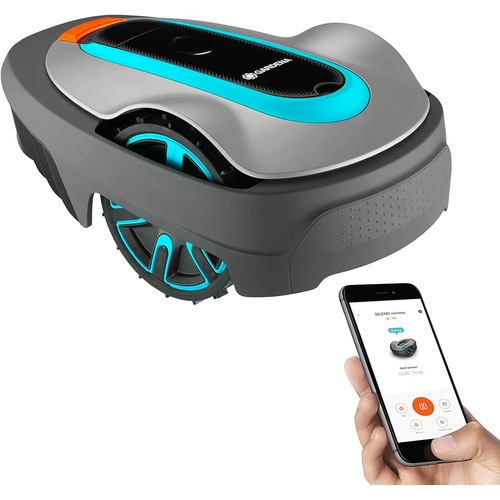
Gardena Sileno City 15002-20
Intelligent robotic mower, mows up to 5400 sq ft, patented streak-free cutting, Bluetooth connectivity, precise navigation, safe, all-weather, DIY installation.
The best robotic mower for small yards is the Gardena Sileno City 15002-20. It can handle lawns up to ⅛ acre and is tied with the Yard Force NX100i as the cheapest mower on our list.
It’s safe, reliable, and easy to configure. You can manage mowing through its user-friendly app, and cleanup is quick because you just have to spray it with a garden hose. The 15002-20 cuts grass rain or shine, and it doesn’t skip spots that are hard to reach thanks to its spot-cutting feature.
Specifications
- Battery: 18 volts
- Connectivity: Bluetooth
- Cutting heights: 0.8 – 1.8 in.
- Cutting width: 6.3 in.
- Lawn size: Up to ⅛ acre
- Max slope: 19°
- Noise level: 57 dB
Special Features
| All-Wheel Drive | No |
| Anti-theft | No |
| GPS | No |
| Virtual Assistant Compatible | No |
Pros and Cons
| What We Liked | What We Didn’t Like |
| ✓ Mows low ✓ Affordable ✓ Quiet ✓ Easy to clean ✓ Reliable | ✗ Narrow cutting height range ✗ Can’t handle steep slopes ✗ Not as many features as high-end models ✗ Uses a boundary wire |
Buyer’s Guide
When shopping for a robotic lawn mower, please consider the following:
- How Robotic Mowers Work
- Battery Voltage
- Mowing Area
- Cutting Width
- Cutting Incline
- Cutting Heights
- Noise Level
- Special Features
- Prices
How Does a Robot Lawn Mower Work?
Having a robot do your yard work for you might sound too good to be true, but how a robot lawn mower works is quite simple; they are similar to robot vacuums. All robot lawn mowers run on rechargeable batteries, so you never have to worry about refueling them.
How do they find their way around your yard?
Most models respond to a perimeter wire, much like a dog with a shock collar responds to an invisible pet fence.
How does the perimeter wire work?
To set up a robotic lawn mower, you install a wire around the area you want the robot to mow. Sometimes you bury the perimeter wire, and sometimes you secure it to the ground with pegs.
The wire sends out a signal, which the mower receives. The mower will turn around when it gets close to the boundary wire. That way, it doesn’t leave your property or damage landscape features like flower beds.
When do they mow?
Depending on the mower, it might run a pre-set amount of times per week, or you might be able to set up a completely customized mowing schedule.
Either way, when the robot mower is out working and the battery runs low, it will return to the docking station on its own to recharge. This is a standard feature, so you won’t have to worry about it dying in the middle of the lawn.
Where do the grass clippings go?
Robotic mowers finely mince grass clippings to just a few millimeters. The fine mulch degrades into the soil, fertilizing your lawn. Mulched grass clippings are one of the best lawn fertilizers. They are nitrogen-rich, inspiring dense green grass growth.
Battery Voltage
Most robotic mowers run on lithium-ion batteries. The higher the battery’s voltage, the higher your mower’s power output will be. More power means the mower will be able to take on thicker and longer grass.
Mowing Area
Please pay attention to the model’s mowing area because this is the maximum yard size it can handle. If your yard is a full acre and you buy a robot mower with a mowing area of ¼ acre, only part of your lawn will get cut.
On the other hand, if your yard is ¼ acre and you buy a mower suited for an acre or more, you’re probably spending a lot more money than you need to. Robotic mowers for smaller lawns tend to cost less than those for larger lawns, as shown in the table below.
| Max Yard Size | Average Price |
| < ¼ acre | $1,000 |
| ¼ acre | $1,135 |
| ½ acre | $1,300 |
| 1 acre | 2,250 |
Cutting Width
Like with any other lawn mower, the cutting width (the size of the cutting deck) tells you how much ground a robot mower will be able to cover in one pass. Mowers with larger cutting widths finish mowing quicker.
Of course, the speed of the job doesn’t matter as much with a robot lawn mower as it does with other mowers; you won’t be doing any of the work yourself. However, mowers with larger cutting widths tend to handle larger yards. On the flip side, smaller mowers fit better through narrow passages.
The table below shows robotic mowers’ typical max yard size by cutting width.
| Cutting Width | Typical Max Yard Size |
| < 8 in. | ⅓ acre or less |
| 8 – 9 in. | ¼ – ½ acre |
| 10+ in. | ¾ – 1 ¼ acres |
Cutting Incline
A robotic lawn mower’s maximum cutting incline is how steep of a slope it can climb. If you have any incline in your yard, make sure you know its slope so you can choose a robot mower that will be able to climb it.
We measured the slope in degrees, but you’ll find that some product pages give a percentage instead. You can easily convert the percentages to degrees with an online calculator.
Cutting Heights
Lawn mowers have multiple cutting height adjustments, so you can choose how tall you want your grass. However, some mowers have a wider cutting height range than others.
The table below shows ideal mowing heights for common turfgrasses. You want a mower that manicures your lawn to the perfect height.
| Grass Type | Ideal Mow Height |
| Bahiagrass | 3 – 4 in. |
| Bentgrass | 0.25 – 1 in. |
| Bermudagrass | 0.5 – 1.5 in. |
| Buffalograss | 2 – 4 in. |
| Centipedegrass | 1 – 2 in. |
| Fine Fescue | 1 – 3 in. |
| Kentucky Bluegrass | 2 – 3 in. |
| Perennial Ryegrass | 1 – 3 in. |
| St. Augustinegrass | 2 – 4 in. |
| Tall Fescue | 2 – 4 in. |
| Zoysiagrass | 1 – 2.5 in. |
Noise Level
If you live close to your neighbors, you probably don’t want to burden them with a noisy machine. The good news is that all robotic lawn mowers are battery-powered, thus much quieter than gas mowers.
While gas lawn mowers tend to produce about 90 decibels (dB) of sound, most robot mowers produce 60 to 75 dB.
Special Features
It’s fine to focus on the mower’s main specs, but don’t forget to consider these special features:
- GPS tracking: GPS in a robotic mower serves a few purposes. It can help the mower navigate your lawn more accurately, but it’s also helpful for security. If someone steals your mower, you can track it down quickly.
- All-wheel drive: All-wheel drive isn’t common in robot mowers. If your yard has a lot of rugged terrain, steep slopes, or other complications, you might need to spend a little extra for a machine with all-wheel drive.
- Wi-Fi connectivity: When a mower connects to Wi-Fi, you’ll usually be able to access it from anywhere in the world. However, you may be able to buy an extra attachment to connect to the Internet even if a mower doesn’t come with it.
- Virtual assistant compatibility: Some robot mowers can connect to “smart home” virtual assistant systems such as Amazon Alexa or Google Home. With this feature, you can give a voice command like “Alexa, mow the lawn”.
- Security PIN code: For extra security, some robot lawn mowers only run after you’ve entered a PIN. It’s like unlocking your phone with a passcode. Just like a thief can’t use your phone without the passcode, he won’t be able to use your mower without the PIN.
Price
Most robotic lawn mowers cost $700 to $2,650 and the models on our best robotic lawn mower list cost $1,000 to $2,650. Robotic mowers cost significantly more than a standard push mower but less than many of the best lawn mowers for large lawns.
| Average Cost of Robotic Mowers | $1,500 |
| Typical Price Range of Robotic Mowers | $700 – $2,650 |
| Average Cost of the Best Robotic Mowers | $1,845 |
| Price Range of the Best Robotic Mower | $1,000 – $2,650 |
For comparison, most push lawn mowers cost $115 to $370, while the best push mowers cost $90 to $575. Most self-propelled lawn mowers cost $450 to $1,500, and a typical lawn tractor costs $1,350 to $4,000. The best zero-turn mowers are the most expensive, costing about $4,000 to $6,100.
FAQs About Robot Lawn Mowers
1. How long do robot lawn mowers last?
It’s hard to know how long robot lawn mowers last since modern ones have only been around for a few years. With proper maintenance, there’s no reason a robot mower shouldn’t last for ten years or more.
The batteries will go out much sooner, though, and you’ll probably have to buy replacements every two to three years.
2. What maintenance does a robot lawn mower need?
You want to keep your robotic mower clean with sharp blades:
- Cleaning: Like other lawn mowers, you’ll need to clean the underside of your robot mower regularly. Ensure that grass clippings, caked-on dirt, and other debris don’t build up around the wheels and other moving parts. Improper cleaning can slow down your mower or cause malfunction.
- Blades: You’ll also need to replace the blades regularly for maximum cutting performance. How often you replace them will depend on the specific model.
3. What are the best cordless electric lawn care tools?
If you’re sick of smelling gas fumes, you can try using cordless electric lawn care tools. Here are some of the best ones:
- Leaf Vacuum: The best cordless leaf vacuum is the Ryobi RY404150.
- Leaf Blower: The best cordless electric leaf blower is the Ego Power+ LB7654.
- Hedge Trimmer: The best cordless electric hedge trimmer is the EGO Power+ HT2400.
- String Trimmer: The best cordless electric string trimmer is the WORX WG191.
- Lawn mowers: Robotic models aren’t the only cordless electric mowers. If robotic mowers are outside your price range or too new-fangled for your taste, you can take a look at the best battery-powered lawn mowers.
When to Call a Lawn Care Pro
If you don’t have the time or taste for lawn mowing, robotic mowers aren’t your only option. There are affordable lawn care pros throughout the U.S., and robots can’t compete with a human’s touch.
LawnStarter manages a network of qualified pros with reasonable rates. Our pros must pass a background check, carry insurance, and have superb customer reviews. And, like the best robotic mowers, you can manage your lawn care entirely through a user-friendly app. Get a free online quote today and see how easy keeping a pristine lawn can be.
LawnStarter participates in the Amazon Services LLC Associates Program and other retailer affiliate programs. LawnStarter may earn revenue from products promoted in this article.
Main Image Credit: lutavia / Canva Pro / License wih Text Overlay using Canva Pro

![7 Best Gas Lawn Mowers of 2025 [Reviews] person usiing lawn mower with text overlay on it](https://www.lawnstarter.com/blog/wp-content/uploads/2021/07/Best-Gas-Lawn-Mowers.jpg)
![10 Best Lawn Mowers for Small Yards in 2025 [Reviews] lawn mower cutting grass of small yards with text overlay on it](https://www.lawnstarter.com/blog/wp-content/uploads/2021/01/Best-Lawn-Mowers-for-Small-Yards.jpg)
![9 Best Push Lawn Mowers of 2025 [Reviews] push lawn mower in a yard with text overlay on it](https://www.lawnstarter.com/blog/wp-content/uploads/2023/11/Best-Push-Lawn-Mowers.jpg)
![8 Best Lawn Mowers of 2025 [Reviews] lawn mower cutting grass with text overlay on it](https://www.lawnstarter.com/blog/wp-content/uploads/2021/02/Best-Lawn-Mowers.jpg)